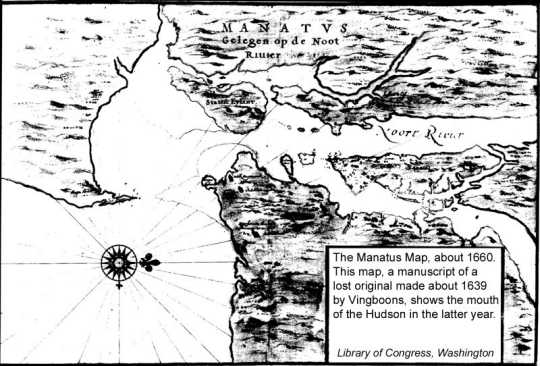Shortage and War
Even in 1642, when the colony was at the height of its development before the devastation of the Indian war, Kieft complained he got too little grain from Rensselaerswijck.In that year, the winter crops on Manhattan had miserably failed.By contrast, the summer crops in 1642 were a success on Manhattan. In September Kieft expected to have fifty lasts of rye and twenty lasts of peas in his granary. It is about the only positive news we have from Manhattan agriculture in all these years. In 1643 there was again great shortage on Manhattan. Dried fish had to be imported from New England, "of pork, beef and peas we shall with God's help obtain enough here in New Netherland" it was stated.noteIn the summer of 1644, as a consequence of the war, there was shortage again. The Company didn't know "Wherewith to feed or to maintain the soldiers" and tried to get provisions from Curacao.note

The Manatus Map of 1639 shows farms no. 2, 3, 4, 5, and 6 as decayed farms, "of which now three again have been occupied". This fits with the situation after May 1639, when farms no. 3, 5 and 6 were again in operation, after they had beenleased to Leendert Arentsen, Hendrick Hermansen and Jan van Vorst respectively. These three Company farms were leased on equal conditions. All tenants had to deliver half of their crops and half of their new-born cattle to the lessee, and in addition, 30 pounds of butter per year were to be paid. The farms had an average of three cows and three horses to start with.
Separate from these lease contracts, that were made up soon after Kieft's arrival, six cows were leased to three different individuals against half increase and thirty or forty pounds of butter per cow. In one case, the lessor also had to pay three mengels of sweet milk and three mengels of buttermilk per week.
Apparently, the new lease contracts for the farms in 1638-1639 (when the conditions for Van Twiller to continue exploiting farm no. 1 were alo set on a new footing) did not have the expected results. Half a year after the expiring of the contracts with Leendert Arentsen and Cornelis Claessen Swits on farms no. 3 and 5 in 1645, these farms were transported to their lessors. In February 1646, no. 4 was conveyed, followed in the next year by the remaining farms no. 2 and 6.note After farm no. 2 had been conveyed to Harmen Smeeman in April 1647, the Company kept only one foothold in Manhattan's agriculture, farm no. 1.note
Van Twiller tried to run this farm as best as he could by hiring tenants from his own native region on the western Veluwe. First, in May 1639, he contracted with a certain Aert Willems of Garderbroek and his wife to manage the Manhattan farm for 200 guilders per year and a free passage. Two years later, he hired two young men from Voorthuizen and Putten to work on his farm. It was certainly not coincidental that these people all came from the Nijkerk region on the Veluwe. In the contract of 1641 it is expressly stated that the two farm hands had to sow, mow, plough, etc. in the Gelderse manier, the way they were used to in Guelderland.note
